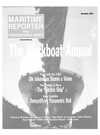
Record Spend on Propulsion?
With commercial shipbuilding output expected to top 40-million gt in 2005 and 2006, attended by a shift to higher installed powers, the global spend on marine propulsion systems is set to hit record levels. A new report from analysts Douglas-Westwood forecasts that the value of the propulsion market will grow to $5.3- billion in 2004, from last year's $4.7-billion, and is anticipated to reach $5.7-billion in 2005 and nearly $5.9-billion in 2006.
The World Marine Propulsion Report 2004-2008 indicates that main engine power installations for 2004 will reach 18-GW. and that new records will be set in each of the two succeeding years, peaking at some 20- GW in 2006. One of the strongest influences is buoyant investment in the containership market, characterized by the trend towards higher capacity, more powerful newbuild tonnage.
Taking a five-year view, it is anticipated that the market for propulsion systems over the period 2004-2008 will exhibit 21 percent growth, in monetary terms, relative to 1999-2003, and that the market for engines will increase by 22-percent.
Main engines will account for $3.85-billion of the total $5.3-billion propulsion plant expenditure for new installations in 2004, increasing to $4.15-billion and $4.29-billion for 2005 and 2006. On this basis, prime movers would up more than 70-percent of the value of the overall shipboard propulsion systems.
In 2007 and 2008. with newbuilding production falling back to around 35 million gt, the annual value of propulsion business would show a commensurate fall to just under $5 billion, with an engine market of around $3.6 billion.
To give added perspective to the sector's economic worth, the $5.3 billion propulsion market for 2004 may be set against a projected, total shipbuilding output value of some $42 billion. The latter is forecast to grow to around $45 billion in each of the peak years of 2005 and 2006. The compilers of the new report forecast that China's shipbuilding industry will account for 13 percent of main engine installations by value by 2008, compared with 7 percent in 1999. Although South Korea is also set to deliver substantially more vessels over the 2004-2008 period, its share of global engine value is not expected to increase much beyond the 30- percent achieved in 2003.
"The high power requirements for container vessels mean that this vessel sector will continue to require the greatest amount of main engine power," say the report's authors, adding "This will be followed by tankers and bulkers/general cargo vessels." Surging investment in LNG carriers also has a pronounced proportional effect on power demand.
Read Record Spend on Propulsion? in Pdf, Flash or Html5 edition of November 2004 Maritime Reporter
Other stories from November 2004 issue
Content
- Austal Launches 417 ft. Aluminum Ship page: 9
- Design Completed for Steamship Authority Ferry page: 9
- Blount to Deliver MV Isleno page: 10
- SF Bay Ferry Logs Impressive Performance page: 11
- NASSCO Holds Ceremony for Fourth BP Tanker page: 12
- K&C Wins $6M Navy Contract page: 12
- Air Emissions from Ships page: 14
- Shipboard Training Comes of Age page: 17
- Demystifying Parametric Roll page: 20
- A Bright Spot in Oil Patch Vessel Construction page: 26
- Senesco Marine Signs Contract For 140,000-Barrel DH ATB page: 30
- Coffee Company Investigates MContainer-on-BargeM Service page: 31
- USCG Invests in Low Engine Exhaust Temps page: 33
- Seacraft Delivers RV Hercules page: 36
- Caterpillar Gets "ACERT"-ive page: 37
- Making the Mark For Crescent Towing's Fleet page: 40
- The New Wartsila 46F page: 41
- Market Vision with Wartsila s Ole Johansson page: 42
- VT Halter Launches PCTC page: 44
- Aluminum Industry Continues Support for the Marine Market page: 46
- Film Celebrates Golden Age of NW Boats page: 47
- Pressure Transmitter Receives ABS Approval page: 48
- Fire Prevention: "Rising" to the Occasion page: 48
- For Those in Peril page: 50
- A Future in Composites page: 52
- Extra Value in Chinese Construction page: 53
- Record Spend on Propulsion? page: 54
- Collaboration Creates Vehicle for CNG Solutions page: 56
- Milestone Reference with MAN B&W page: 58
- The Will for Business page: 58
- Wider Remit for Dutch Matchmaker page: 58
- 2n d Generation Onboard NAPA Tanker Released page: 58
- Nichols Named "Maritime Man of the Year" page: 59
- ACBL Makes Appointments page: 59
- International Paint Japan K.K. - Open for Business page: 60
- European Yard Initiative - Will it Work? page: 62
- A.P. Meller-Maersk Creates Dedicated Tech Group page: 64
- SembCorp Signs Breakthrough, Long Term LNG Deal page: 66
- Keppel Batangas Completes SemiSub Repair page: 68
- A&P Tyne Re-Delivers FPSO Haewene Brim page: 68
- Crane Materials Launches TimberGuard page: 70
- Fincantieri Orders Water- Lubed Shaft Bearings page: 70
- Bilge Water Treatment Unit Approved By LR page: 71
- Electric Propulsion for Coastal Ships page: 72
- ALSTOM Wins $102M Navy Deal page: 73
- Offshore & Marine Chose Vacon AC Drives page: 73
- Successful Full Load Operation of 5-MW Ship Propulsion Motor page: 74
- Innovative Tweendeck Patented in U.S. page: 76
- MAN B&W Records Busy Hamburg Show page: 77
- Transas Demonstrates New Tech at SMM page: 77
- BV Launches Project Management Solution page: 78
- Xantic Offers New Web-Based Tool page: 79
- New AIS Targets U.S. Workboat Market page: 80
- Hepworth Makes a Good Show at SMM page: 80
- New PVC-Free Alternatives for Interior Decoration page: 80
- A High-End Global Satcom Presence page: 82
- IPS Marine Lands New Blue Chip Casino page: 85
- Rigdon Marine Promotes Harkness to CFO Post page: 85
- Tidewater: Effects of New Tax Bill Are Positive page: 86
- Bollinger to Design, Build Five DH Hot Oil Barges page: 87
- B+V Wins Passenger Ship Contract page: 88
- In Remembrance: Captain Fred Kosnac Jr. (1928-2004) page: 92
- Electronic Charting Aboard APL China page: 93
- Electric Boat Optimizes Nuclear Sub Repairs page: 94
- Kramek, Liu Snare Top SNAME Honors page: 97


